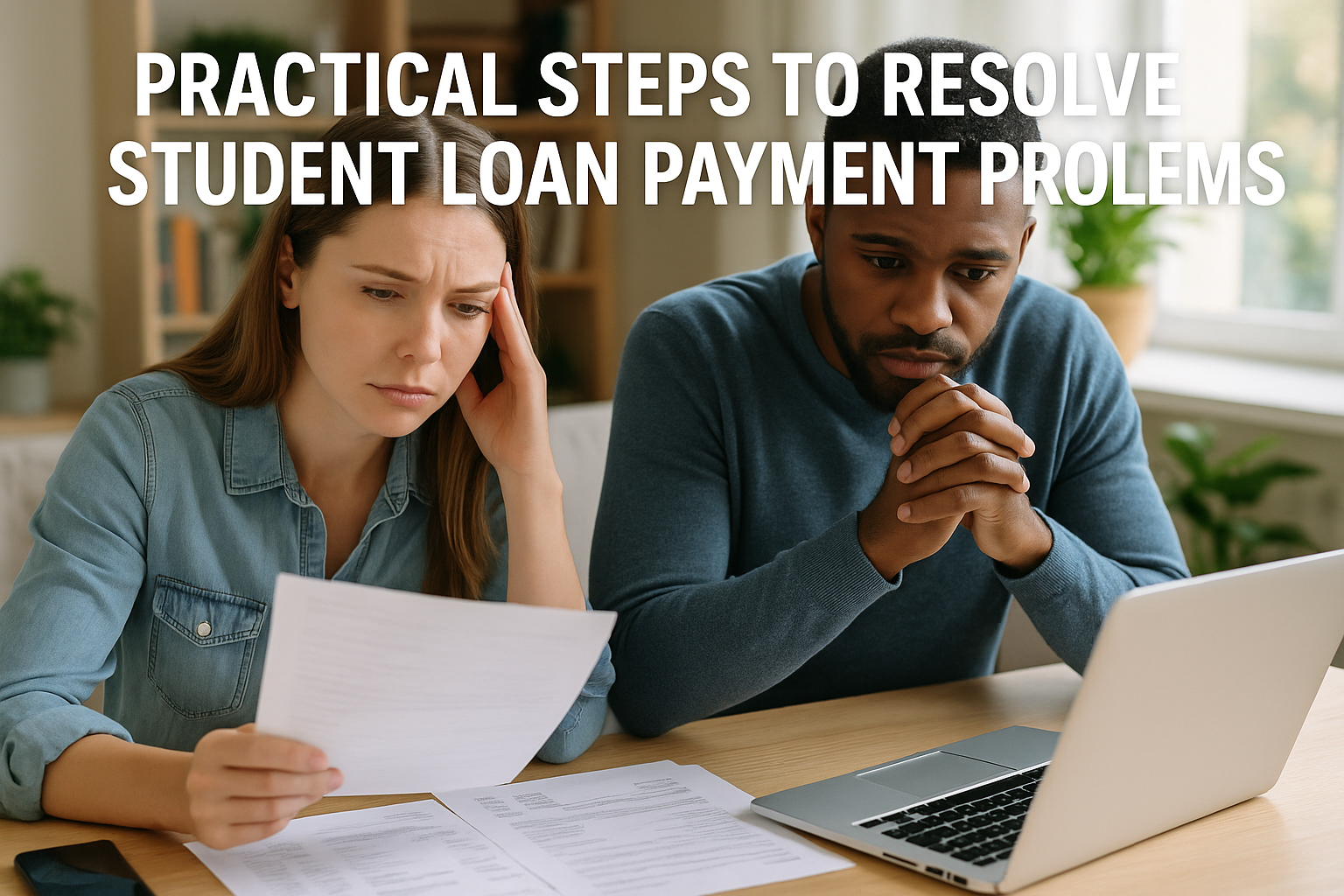USA Student Loan forgiveness and deferment: Falling behind on federal student loans is scary — but you’re not alone, and there are clear steps you can take to stop the situation from getting worse. This guide shows exactly what deferment and forbearance do, how delinquency becomes default, how to consolidate or dispute accounts, and how to use the Federal Student Aid Ombudsman when your servicer can’t help.
Quick summary — what to do first
- Call your loan servicer right away — don’t wait.
- See whether deferment or forbearance is appropriate for a temporary pause.
- If your loan is already delinquent, act immediately to avoid default and its consequences (credit damage, wage garnishment, tax refund offset).
- If the servicer won’t resolve your issue, escalate to the Federal Student Aid (FSA) Ombudsman.
1) Contact your loan servicer — the single most important first step
If you miss or will miss a payment, contact the loan servicer shown on your Federal Student Aid account (studentaid.gov). Servicers can:
- Explain why your payment is late and what options you qualify for.
- Offer income-driven repayment (IDR) enrollment, deferment, or forbearance.
- Provide instructions for loan consolidation or rehabilitation if you’re near or in default.
Document the call: write down the date, agent name, confirmation number, and any next steps they promise. This record is vital if you later need to escalate.
2) Understand the difference: deferment vs. forbearance
Both temporarily postpone or reduce payments — but they work differently:
- Deferment: your required payments are postponed. For some loan types (e.g., subsidized federal loans under qualifying deferments), the government may pay interest during the deferment. Deferment is usually the better option when you qualify.
- Forbearance: payments are suspended or reduced, but interest continues to accrue on all loan types, which increases the total you’ll owe. Forbearance is useful for short-term financial hardship but can be costly over time.
Ask your servicer which option you qualify for and get the decision in writing.
3) If you’re delinquent, act before default
- Delinquent: a payment is late — even one day late is delinquent. If delinquencies continue (timeframes vary by loan type), the loan may enter default.
- Default consequences: once in default, serious actions can follow, such as wage garnishment (up to 15% of disposable pay), Treasury offset (tax refunds and federal payments withheld), damaged credit reports, and collection fees. You’ll also lose access to new federal student aid.
If you’re delinquent, ask your servicer about:
- Rehabilitation (making a series of agreed payments to remove default status), or
- Direct Consolidation (may help you get out of default and return to good standing). Both have rules and pros/cons — get clear instructions from the servicer and confirm in writing.

4) Consolidation — when it helps (and when it doesn’t)
A Direct Consolidation Loan combines multiple federal loans into one payment. Consolidation can:
- Simplify payments,
- Potentially reopen eligibility for repayment plans or post-default options.
But consolidation may lengthen repayment and increase total interest paid. It can also affect progress toward some forgiveness programs (so check before you consolidate). Review the tradeoffs on StudentAid.gov and with your servicer.
5) How to dispute errors — step-by-step
If your servicer’s balance or status looks wrong:
- Gather evidence: payment records, bank statements, email confirmations, your loan history from studentaid.gov.
- Call the servicer: explain the error, reference specific dates/amounts, and request a written response. Log the call.
- Follow up in writing: send a short, dated letter or secure message through your servicer portal summarizing the dispute and attaching copies of your proof. Request a response deadline (e.g., 30 days).
- If unresolved, file a complaint with the FSA Feedback Center and the FSA Ombudsman Group (they are an independent, informal, and confidential resource to help resolve disputes).
Ombudsman contact options include the FSA Feedback Center online, calling 1-800-433-3243, or using the Ombudsman dispute form. Keep copies of every submission.
6) How to get out of default (if it’s already happened)
Options depend on the loan type and your situation:
- Loan rehabilitation — make a series of affordable, documented payments to remove default. Successful rehab removes default from credit reports in many cases.
- Loan consolidation — consolidating a defaulted FFEL or Perkins loan into a Direct Consolidation Loan may be a path out of default (you may need to pay collection costs or agree to a repayment plan).
- Administrative discharge options — in some cases (school closure, false certification, or total and permanent disability), discharge may be available.
Contact your servicer immediately and ask which cure options you qualify for; if they aren’t responsive, contact the Ombudsman. See StudentAid.gov’s “Getting out of default” guidance for step-by-step instructions.
7) If you still can’t resolve the problem — escalate to the Ombudsman
The Federal Student Aid Ombudsman Group helps borrowers with unresolved disputes and complex servicing issues. They can:
- Investigate account problems,
- Help identify administrative fixes, and
- Serve as a neutral go-between with servicers.
Use the Ombudsman after you’ve tried the servicer and used the FSA Feedback Center; they accept cases online, by phone, or by mail. Keep all prior correspondence handy when you submit a case.

8) Scripts: what to say (copy/paste when you call)
Call your servicer (missed payment):
“Hi — my name is [Full Name], account [last 4 digits]. I missed a payment because [brief reason]. I want to prevent default. What are my options for deferment, forbearance, IDR, or rehabilitation? Please send any agreement in writing and give me a confirmation number.”
Dispute balance error script:
“Hello — my account shows a balance/status I don’t agree with. I have payments on [dates] with confirmation numbers [X]. I’m formally disputing the balance. Please tell me what you need and confirm in writing within 30 days.”
Ombudsman opening script:
“Hello — I’ve tried the servicer (dates, agent names) and filed feedback (case #). I’m requesting Ombudsman help to resolve [brief issue]. My FSA ID is [XXX]; my contact info is [phone/email].”
9) Checklist — documents to have ready right now
- Loan servicer name and account number (from studentaid.gov).
- Recent payment records / bank statements showing payments.
- Correspondence from servicer (emails, letters).
- Your Federal Student Aid account statement (download from studentaid.gov).
- Any court or wage-garnishment notices (if you’ve received them).
- Records of hardship (medical bills, unemployment notices) if asking for deferment/IDR.
Short FAQ (fast answers)
Q: Will deferment/forbearance stop collections if I’m already in default?
A: No — deferment and forbearance generally apply before default. If you’re in default, ask your servicer about rehabilitation or consolidation. Contact the Ombudsman if the servicer isn’t helpful.
Q: Can the government garnish my wages without a court order?
A: Yes — for federal student loan defaults, the government (or loan holder) can collect through administrative wage garnishment (up to 15% of disposable pay) without a court judgment.
Q: Will my tax refund be taken?
A: It can be — defaulted federal student loans can trigger Treasury offset, where federal payments (including tax refunds) are used to pay the debt. You should receive a notice before the offset.
Final notes — act early, document everything, escalate if needed
Resolve student loan problems by acting quickly: call your servicer, consider temporary relief (deferment/forbearance) if appropriate, explore consolidation or rehabilitation to cure default, and use the Federal Student Aid Ombudsman for unresolved disputes. Keep meticulous records — they’re your strongest protection.
Disclaimer: This blog post is for informational purposes only and does not constitute legal, tax, or financial advice. Loan terms, program rules and contact details can change. Always verify the latest rules and procedures on official government pages and with your loan servicer before taking action. Images used in this article are royalty‑free or licensed for commercial use and are provided here for illustrative purposes.
Helpful official links (clickable)
- Resolve student loan payment problems — USA.gov. (USAGov)
https://www.usa.gov/student-loan-problems - Deferment & Forbearance — Federal Student Aid (StudentAid.gov). (StudentAid)
https://studentaid.gov/manage-loans/lower-payments/get-temporary-relief - Consequences of Default & Getting Out of Default — Federal Student Aid. (StudentAid)
https://studentaid.gov/manage-loans/default - FSA Feedback Center & Ombudsman Group — submit disputes or request Ombudsman help. (StudentAid)
https://studentaid.gov/feedback-ombudsman - Common loan disputes (what the Ombudsman handles) — Federal Student Aid. (StudentAid)
